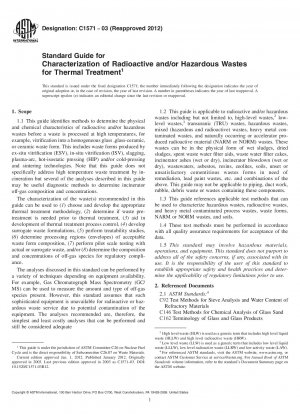ASTM C1571-03(2012)
Standard Guide for Characterization of Radioactive and/or Hazardous Wastes for Thermal Treatment
- Standard No.
- ASTM C1571-03(2012)
- Release Date
- 2003
- Published By
- American Society for Testing and Materials (ASTM)
- Latest
- ASTM C1571-03(2012)
- Scope
This guide identifies methods to determine the physical and chemical characteristics of a variety of hazardous and/or radioactive wastes including heavy metal contaminated wastes. These wastes can be in the physical form of sludges (wet or dry), spent waste water filter aids, waste water filter cakes, incinerator ashes (wet or dry), incinerator blowdown (wet or dry), asbestos, resins, zeolites, soils, unset or unsatisfactory cementitious waste forms in need of remediation, lead paint wastes, radioactively or non-radioactively contaminated asbestos, geologic mill tailings (also known as byproduct materials) and other naturally occurring or accelerator produced radioactive materials (NORM and NARM), etc. and combinations of the above. This guide may not be applicable to piping, duct work, rubble, debris waste or wastes containing these components.
This guide identifies the physical and chemical characteristics useful for developing high temperature thermal treatment methodologies for a variety of hazardous and/or radioactive process wastes and soils including heavy metal contaminated wastes. The waste characteristics can be used to (1) choose and develop the thermal treatment methodology, (2) determine if waste pretreatment is needed, (3) aid in development of thermal treatment process control, (4) develop surrogate waste formulations, (5) perform treatability studies, (6) determine processing regions (envelopes) of acceptable waste form composition, and/or (7) perform pilot scale testing with actual or surrogate waste, and/or (8) determine the composition and concentrations of off-gas species for regulatory compliance.
This guide identifies applicable test methods that can be used to measure the desired characteristics of the hazardous and/or radioactive wastes described in 4.1. The analyses discussed in this standard can be performed by a variety of techniques depending on equipment availability. For example, Gas Chromatograph Mass Spectrometry (GC/MS) can be used to measure the amount and type of off-gas species present. However, this standard assumes that such sophisticated equipment is unavailable for radioactive or hazardous waste service due to potential contamination of the equipment. The analyses recommended are, therefore, the simplest and least costly analyses that can be performed and still considered adequate. Not every characteristic given in this guide is necessary for every waste (see Fig. 1). Cation analysis is necessary for every waste in order to determine whether the final waste form will be a homogeneous glass, a glass-ceramic, or a slag (see Appendix X1).
Waste Analysis Method A is applicable when it is desired to know the amount and type of volatiles to be expected during thermal treatment and their compatibility with the thermal treatment and off-gas unit materials of construction and design capacity. These methods may be used to determine incinerator off-gas composition and concentrations.
Waste analysis Method A is applicable when it is necessary to know the amount of organics in the waste independently of the amount of other volatile constituents present for safety concerns. These methods may be used to determine incinerator off-gas composition and concentrations.
Waste analysis Method A is applicable when it is necessary to know if molten salt formation and accumulation in a thermal treatment unit in the presence of water vapor may be a safety concern.
Waste Analysis Methods B and C are applicable when it is desired to only know the amount of volatiles to be expected during thermal treatment, for example, when speciation of the volatiles and potential molten salt formation is not of concern. These methods may be used to determi......
ASTM C1571-03(2012) Referenced Document
- ASTM C1109 Standard Test Method for Analysis of Aqueous Leachates from Nuclear Waste Materials Using Inductively Coupled Plasma-Atomic Emission Spectrometry
- ASTM C1111 Standard Test Method for Determining Elements in Waste Streams by Inductively Coupled Plasma-Atomic Emission Spectroscopy
- ASTM C1168 Standard Practice for Preparation and Dissolution of Plutonium Materials for Analysis
- ASTM C1317 Standard Practice for Dissolution of Silicate or Acid-Resistant Matrix Samples
- ASTM C146 Standard Test Methods for Chemical Analysis of Glass Sand
- ASTM C1463 Standard Practices for Dissolving Glass Containing Radioactive and Mixed Waste for Chemical and Radiochemical Analysis
- ASTM C162 Standard Terminology of Glass and Glass Products
- ASTM C169 Standard Test Methods for Chemical Analysis of Soda-Lime and Borosilicate Glass
- ASTM C242 Standard Terminology of Ceramic Whitewares and Related Products
- ASTM C859 Standard Terminology Relating to Nuclear Materials
- ASTM C92 Standard Test Methods for Sieve Analysis and Water Content of Refractory Materials
- ASTM D1129 Standard Terminology Relating to Water
- ASTM D4327 Standard Test Method for Anions in Water by Chemically Suppressed Ion Chromatography
ASTM C1571-03(2012) history
- 2003 ASTM C1571-03(2012) Standard Guide for Characterization of Radioactive and/or Hazardous Wastes for Thermal Treatment
- 2003 ASTM C1571-03 Standard Guide for Characterization of Radioactive and/or Hazardous Wastes for Thermal Treatment
